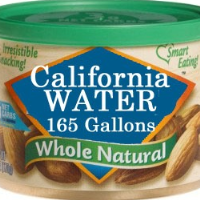California Almond Growing Uses more than 1 Trillion Gallons of Water a Year
 (graphic: Steve Straehley, AllGov)
(graphic: Steve Straehley, AllGov)
Almonds are a premium-priced superfood, credited with reducing heart disease and lowering blood pressure.
The blood pressure attributes, however, might be negated among drought-conscious California consumers if they are aware of the enormous amount of water the state’s farmers in the Central Valley use to grow one of the agricultural giant’s favorite crops.
California provides 80% of the world’s almonds and almost 99% for the nation, but to do it uses 1 trillion gallons of water a year.
It takes 1.1 gallons of water to grow one almond, so a nutritionally-recommended one-ounce serving (20-24 nuts) can use around 25 gallons of water. That compares to 3.3 gallons for a tomato, 3.5 gallons for a head of lettuce, 5 gallons for a potato and 5.4 gallons for a head of broccoli. The U.S. Geological Survey (USGS) says it takes 10 gallons for a slice of bread, 500 gallons for a pound of chicken, 700 gallons for a cotton shirt and 4,000-18,000 gallons to produce a one-third-pound hamburger.
Agriculture uses at least 80% of the state’s water and around 10% is used to grow almonds. That might be changing soon.
The Almond Board of California (pdf) reported a 10.5% drop in foreign exports last month from a year ago, and Blue Diamond Almonds projected a 10% decline in shipments this year. Some of that decline may be due to external market forces on the demand side of the equation, such as a strengthening dollar, Russian import limits, labor actions on West Coast docks and Middle East unrest.
But the drought is a growing factor. Acreage devoted to almonds has doubled since 1994. That wasn’t a big problem in wet years, but those were always sporadic and have been nonexistent lately. Now, to compensate for the loss of some water deliveries from outside sources, they have overdrafted groundwater sources.
A survey (pdf) released in September by the California Department of Food Agriculture (CDFA) and the National Agricultural Statistics Service (NASS) found that 79% of almond farmers that use surface water are receiving less than the year before. Fifty-two percent said they would be pumping more groundwater than the year before
That’s a problem, beyond rapidly using up a resource that took generations to accumulate. The pumped-out wells produce saltier water and that is hard on the almonds. Survey responders said 73% of their “operation’s groundwater supply is higher in salinity than the recommended amount for irrigation of almonds.”
Nearly 78% said they expected “a negative impact on tree health or harvest quantity/quality in 2014 due to the application of high saline groundwater.”
Even as almond farmers overburden groundwater sources, they face heavy competition for surface water. For instance, they share water from the Klamath River up north with local tribes that rely on salmon runs for their livelihood.
To preserve the salmon, federal actions have slowed the amount of water released from the river into Trinity Lake while maintaining the flow of water from the lake to the Sepulveda Basin and ultimately farther south to farmers. That will drain the lake sooner than later and could come to a head next year.
–Ken Broder
To Learn More:
How Almonds Are Sucking California Dry (by David Willis, BBC)
California's Insane Nut Boom, in 3 Simple Charts (by Lei Wang, Mother Jones)
Can We Afford to Keep Loving Almonds? (by Katy Gathright, Groundswell)
The Thirsty West: 10 Percent of California’s Water Goes to Almond Farming (by Eric Holthaus, Slate)
Almond Growers Turn to Groundwater amid Drought (by Tim Hearden, Capital Press)
California Drought Has Wild Salmon Competing with Almonds for Water (by Alastair Bland, NPR)
Focus Is on Pesticides as 80,000 Bee Colonies Damaged or Destroyed (by Ken Broder, AllGov California)
International Boom in Demand for California Almonds Threatens Water Supply in Times of Drought (by Noel Brinkerhoff, AllGov)
2014 Almond Drought Survey (California Department of Food Agriculture and National Agricultural Statistics Service) (pdf)
- Top Stories
- Controversies
- Where is the Money Going?
- California and the Nation
- Appointments and Resignations
- Unusual News
- Latest News
- California Forbids U.S. Immigration Agents from Pretending to be Police
- California Lawmakers Urged to Strip “Self-Dealing” Tax Board of Its Duties
- Big Oil’s Grip on California
- Santa Cruz Police See Homeland Security Betrayal in Use of Gang Roundup as Cover for Immigration Raid
- Oil Companies Face Deadline to Stop Polluting California Groundwater





